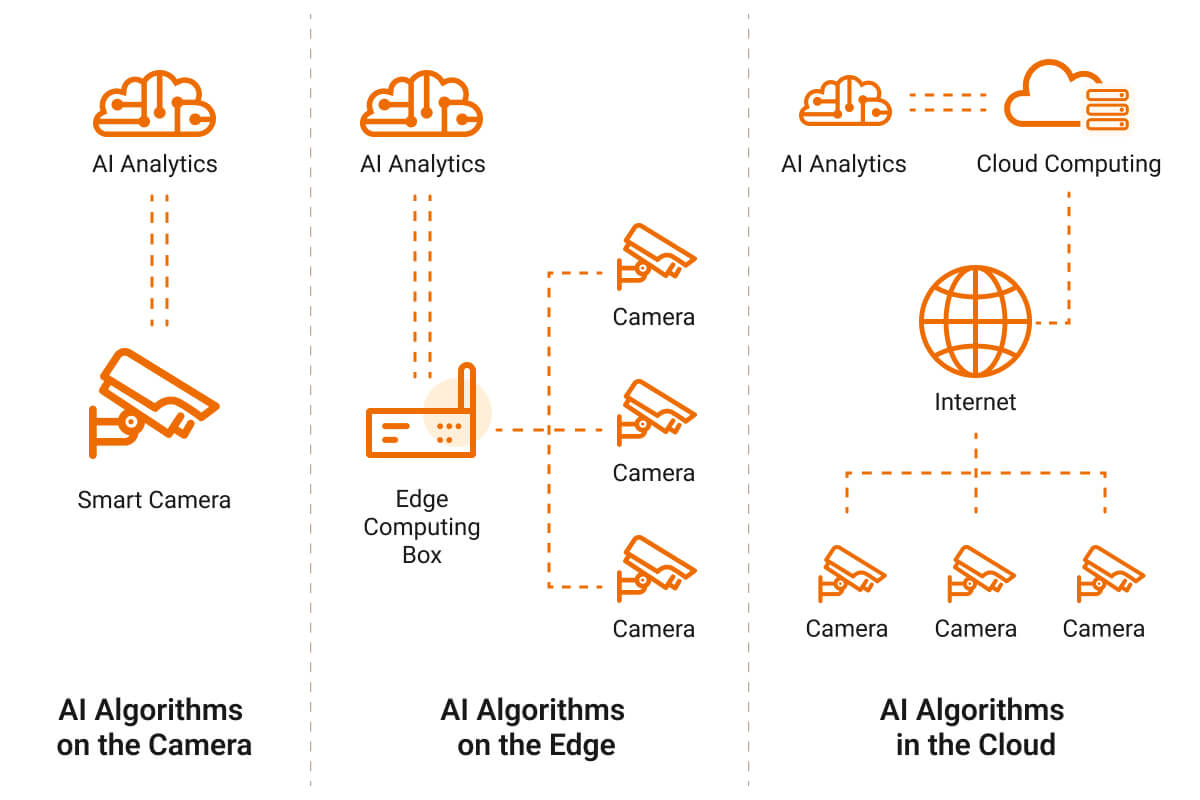IoT technology plays a significant role in enhancing the functionality, efficiency, and overall performance of HVAC (Heating, Ventilation, and Air Conditioning) systems. This article explains the components of smart HVAC systems and their applications, and recommends IoT gateways suitable for smart HVAC systems.
What Does IoT HVAC System Mean?
Heating, ventilation, and air conditioning is referred to as HVAC. It describes the methods and tools employed to provide heating, cooling, and suitable ventilation in structures and vehicles. In order to provide comfort, safety, and ideal circumstances for people, smart HVAC systems are designed to regulate the temperature, humidity, and air quality within an enclosed space.
An smart HVAC system’s heating component typically consists of a furnace or a heat pump that produces heat to warm the air during the colder months. An air conditioner or a refrigeration system that removes heat from the indoor air during the warmer months constitutes the cooling component. The process of ventilation involves replacing the stale interior air with clean outdoor air in order to get rid of impurities, odors, and extra moisture.
Residential, commercial, and industrial buildings as well as automobiles, trucks, and aircraft frequently include smart HVAC systems. By controlling the temperature, humidity, and airflow inside the home, they are essential for preserving a comfortable and healthy atmosphere.
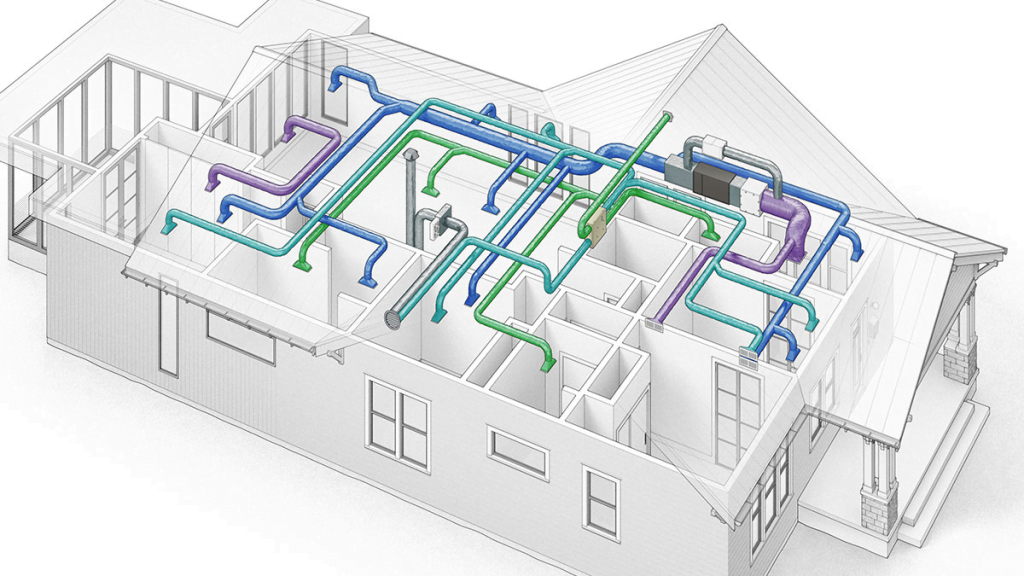
What Are Components Make Up an IoT HVAC System?
An smart HVAC system consists of several components that work together to provide heating, ventilation, and air conditioning. While the specific components can vary depending on the type and complexity of the system, here are some of the key elements:
- IoT Gateway: The smart HVAC system is connected to the internet via an IoT gateway, which enables remote monitoring and control. It enables users to change settings, get alerts, and gather information about the system’s efficiency.
- Thermostat: You can regulate the temperature within your house using the thermostat. Your thermostat sends a signal to the rest of your smart HVAC system when you adjust the temperature, telling it whether you want your home to be warmer or cooler.
- Furnace: The air in the system is heated by the furnace or heat pump. Heat is produced by burning fuel (such as gas or oil) in furnaces, while heat is taken from the ground or air and transferred indoors via heat pumps.
- Air Conditioner: An air conditioner cools your home by removing heat and humidity from inside and transferring it outside.
- Ventilation System: The ventilation system makes sure that interior and outdoor air are being exchanged. It consists of air ducts, blowers, and filters that circulate clean air, eliminate stale air, and regulate the indoor air quality.
- Air Filters: By removing impurities from the air, air filters enhance indoor air quality by capturing dust, pollen, and other airborne particles. They frequently reside in the smart HVAC system’s return air ducts.
- Ductwork: A network of ducts called ductwork is used to transfer heated or cooled air across a structure. It is made up of return ducts, which carry air back to the smart HVAC system, and supply ducts, which distribute conditioned air.
- Sensors and Controls: The smart HVAC system receives data from a variety of smart sensors, including temperature sensors and humidity sensors. Relays, switches, and motorized dampers are examples of controls that govern system function based on data from sensors and human preferences.
- Compressor and Condenser: These components are specific to air conditioning systems. The compressor pressurizes the refrigerant, and the condenser releases heat from the refrigerant to the outside air.
- Heat Exchanger: Between the indoor air and the furnace or heat pump, the heat exchanger transports heat. The heat exchanger warms the air in a furnace through direct contact, whereas in a heat pump, it moves heat from the refrigerant to the air.
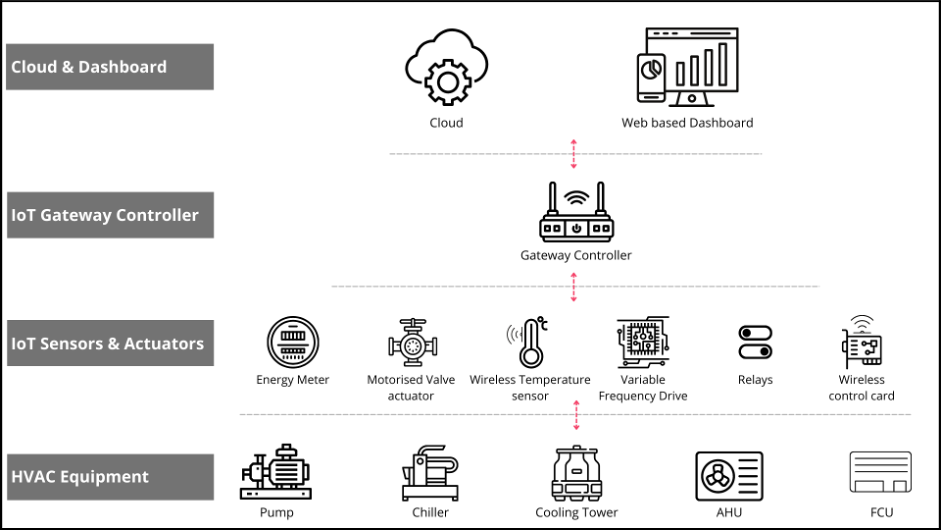
Benefits of IoT HVAC System
Smart HVAC system based on IoT gateways brings lots of benefits:
Energy Savings
HVAC systems that are designed and manufactured with energy efficiency in mind can provide significant energy savings for end-users. IoT gateways enable energy management features by providing access to energy consumption data and system performance metrics.
Read Case Study: Energy Management using IoT technology
By incorporating advanced technologies, such as variable speed motors, high-efficiency components, and intelligent controls, manufacturers can develop HVAC equipment that operates more efficiently, reducing energy consumption and costs for the end-user.
Predictive Maintenance
The IoT Predictive Maintenance gateway in a smart HAVC system, coupled with data analytics, supports predictive maintenance strategies. By integrating smart sensors to monitor equipment performance and collect real-time data, manufacturers can detect potential issues or anomalies in the system. This data can be used to schedule maintenance proactively, identify equipment failures in advance, and optimize equipment performance, reducing downtime and improving customer satisfaction.
Remote Monitoring and Diagnostics
With an IoT gateway, manufacturers and end-users can remotely monitor and control the HVAC system. By collecting data on parameters such as temperature, pressure, and energy consumption, manufacturers can analyze the data, identify trends, and offer remote diagnostics. This capability enables faster troubleshooting, reduces the need for on-site visits, and enhances customer support.
Product Differentiation
By incorporating advanced features, technologies, and smart capabilities into their HVAC systems, manufacturers can differentiate themselves from competitors. Energy efficiency, predictive maintenance, remote monitoring, and other innovative functionalities can position manufacturers as leaders in the market, attracting customers who seek advanced and reliable HVAC solutions.
Improved Customer Experience
With the help of the IoT gateway, building owners and managers may remotely monitor and manage their HVAC systems using smartphones, tablets, or web-based interfaces. Users may change temperature settings, access real-time data, and get alerts or messages thanks to this convenience, which improves their overall experience and comfort. By offering intuitive mobile applications and user-friendly system control and administration interfaces, manufacturers may set their goods apart from the competition.
Data Gathering and Analytics
The IoT gateway makes it easier to gather and examine HVAC system data. Manufacturers can acquire useful information on user behavior, energy usage trends, and system performance. Utilizing this information can enhance system performance, increase energy efficiency, and provide individualized suggestions for energy conservation. The data can also be used by manufacturers to spot possible problems or inefficiencies, resulting in proactive maintenance and service options.
Communication Interface for IoT HVAC System
The choice of IoT protocol for an smart HVAC system depends on various factors, including the specific requirements of the system, network infrastructure, scalability, and interoperability needs. There are various IoT protocol can be used in smart HVAC:
- MQTT: MQTT is a lightweight, publish-subscribe messaging protocol designed for efficient communication in constrained environments. It is widely used in IoT applications, including smart HVAC systems. MQTT’s low overhead and efficient data transmission make it suitable for resource-constrained devices and networks with limited bandwidth.
- BACnet: BACnet is a widely adopted protocol specifically designed for building automation and control systems, including smart HVAC systems. It provides a standardized communication protocol for devices within a building, allowing interoperability and seamless integration between different components and subsystems.
You may be interested in What is a BACnet Gateway and BACnet Router in IoT Application?
- Zigbee: Zigbee is a low-power wireless communication protocol based on the IEEE 802.15.4 standard. It is commonly used in home automation systems, including smart HVAC applications. Zigbee provides reliable and low-latency communication, making it suitable for HVAC control and sensor networks. Explore DSGW-010-4 Zigbee Industrial Automation Gateway here.
- Modbus: Modbus is a widely used serial communication protocol in the industrial automation sector, including smart HVAC systems. It is a simple and robust protocol that allows communication between devices connected over serial lines or Ethernet networks. Modbus is suitable for integrating various smart HVAC components and enables monitoring and control of devices in the system.
You may be interested in What is the Modbus Protocol and How Does It Work?
- Wi-Fi: Wi-Fi is a widely adopted wireless communication standard that provides high-speed data transmission over short distances. Wi-Fi is suitable for connecting smart HVAC systems to local area networks (LANs) and the internet, enabling remote monitoring and control of smart HVAC devices.
| IoT Protocol | Key Features | Suitable For | Bandwidth Efficiency | Interoperability | Application Scale |
| MQTT | Lightweight, publish-subscribe messaging, low overhead | Resource-constrained devices, limited bandwidth networks | High | Good | Small to large scale |
| BACnet | Standardized protocol for building automation and control systems | Building automation, seamless integration in commercial buildings | Moderate | Excellent | Medium to large scale |
| Zigbee | Low-power wireless, reliable communication | Home automation, small-scale smart HVAC applications | Moderate | Good | Small to medium scale |
| Modbus | Widely used serial communication protocol, robust | Industrial environments, smart HVAC integration | High | Good | Small to large scale |
| Wi-Fi | High-speed wireless communication | LANs, internet connectivity, remote monitoring | High | Good | Small to large scale |
As a result, BACnet is specifically designed for building automation systems and offers standardized communication for smart HVAC integration in commercial buildings. At the same time, Modbus is widely used in industrial environments and allows seamless integration of various smart HVAC components. Zigbee or Wi-Fi can also be selected when the smart HVAC application is small.
SoC Technology in IoT HVAC System
Smart HVAC systems often utilize multi-protocol System-on-Chip (SoC) solutions to enable connectivity and communication with various devices and networks. Smart HVAC systems employ multi-protocol SoCs mainly for two reasons:
Interoperability Among IoT Devices
Smart HVAC systems need to communicate with a wide range of devices, including thermostats, sensors, actuators, and other smart home or building automation devices. These devices may use different communication protocols. By incorporating a multi-protocol SoC, HVAC systems can support multiple protocols simultaneously, allowing seamless interoperability and communication with various devices.
Smart HVAC systems are often integrated into existing buildings and infrastructures. These legacy systems may use proprietary or industry-specific protocols. By incorporating a multi -protocol SoC, HVAC systems can interface with legacy systems and seamlessly integrate them into modern IoT environments. This integration preserves investments in legacy equipment and enables a smooth transition to more advanced and connected smart HVAC solutions.
As a smart gateway supplier, Dusun IoT provides a set of smart apartment solutions suitable for home automation. It can be perfectly integrated with the smart HVAC system to save energy and collect useful data.
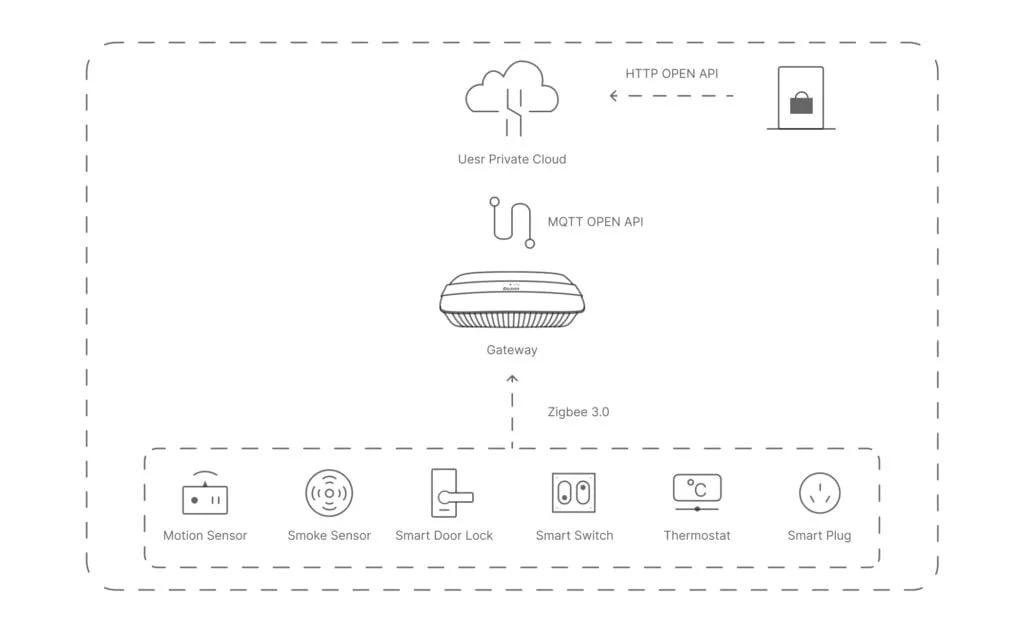
You may be interested in Easily Build Your Smart Building Automation Solutions with Multi-protocol Controller
Simplified Development and Integration
Using a multi-protocol SoC can simplify the development and integration process for smart HVAC systems. Instead of developing and maintaining separate hardware and software solutions for each protocol, manufacturers can leverage a single SoC that supports s multiple protocols. This simplification streamlines development efforts, reduces complexity, and enables quicker time-to-market for smart HVAC products.
Smart HVAC systems are designed to have long lifespans, often spanning several decades. During this lifespan, technology and communication standards may evolve. By using a multi-protocol SoC , HVAC systems can future-proof themselves by supporting multiple protocols, ensuring compatibility with future devices and networks. This scalability allows HVAC systems to adapt to changing technology landscapes and evolving connectivity requirements.
You may be interested in Why Choose Wireless SoCs for IoT Hardware Development & How to Select
Dusun Application for IoT HVAC System
A gateway device made specifically for smart HVAC systems is the DSGW-030 Zigbee Bluetooth Hub by Dusun. In order to facilitate communication and integration between smart HVAC equipment and multiple wireless protocols, including BLE (Bluetooth Low Energy), Z-Wave, Zigbee, and Wi-Fi, it acts as a central hub.
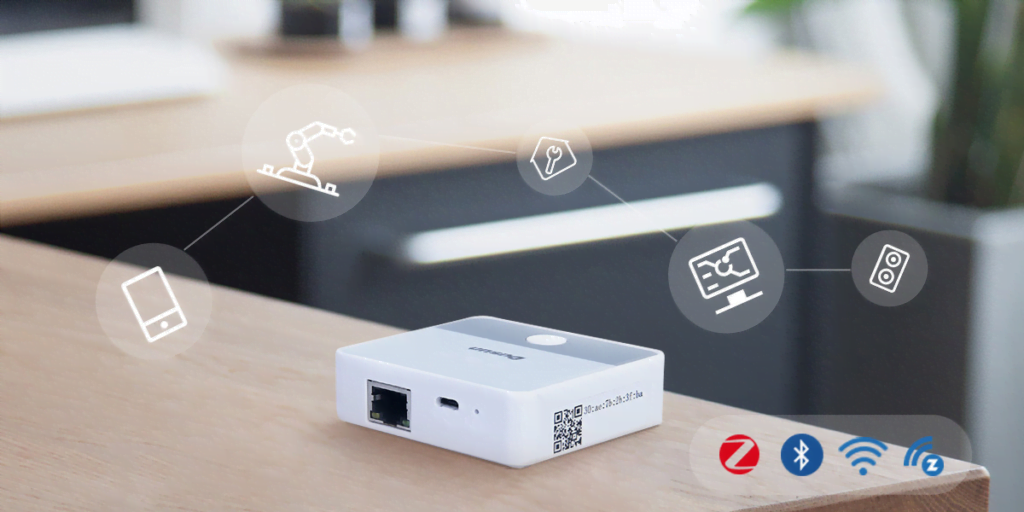
The DSGW-030 Zigbee Ethernet gateway is suitable for smart HVAC systems for the following reasons:
Support for Multiple Protocols
The DSGW-030 is capable of utilizing BLE, Z-Wave, Zigbee, and Wi-Fi. This enables interoperability and integration by allowing it to connect and communicate with a variety of smart HVAC equipment and sensors that implement these protocols.
Centralized Control
The DSGW-030 serves as a gateway device and serves as the main control point for the connected smart HVAC equipment. Through a user-friendly interface or mobile application, it offers centralized monitoring, control, and administration of the smart HVAC system.
Remote Access and Control
Using a smartphone, tablet, or web interface, users of the Dusun DSGW-030 Zigbee Bluetooth hub can remotely access and control their smart HVAC system from any location. Even when users are not physically present, this remote access capability offers simplicity and flexibility in managing the smart HVAC system.
Data analytics and insights
The Dusun DSGW-030 Zigbee BLE gateway is able to gather and analyze data from the connected smart HVAC devices, giving important information about system performance, energy use, and user behavior. These analytics can aid in energy optimization, pattern recognition, and data-driven decision making for increased effectiveness.
Future-Proof and Extendable
The DSGW-030 has an extensible and future-proof design. For extra communication possibilities or potential protocol changes, it supports a USB dongle. The gateway can adapt to changing technologies and communication standards in the smart HVAC industry thanks to its expandability.
Secure and Reliable
Dusun IoT places a strong emphasis on security and dependability in their gateway products. The communication and data integrity of the linked smart HVAC equipment are safeguarded by the encryption methods and security mechanisms built into the DSGW-030.
For more information about DSGW-030, you can visit https://www.dusuniot.com/blog/a-guide-to-understand-dsgw-030-iot-gateway/
Smart HVAC FAQs
What exactly is the difference between AC and HVAC?
The difference between an HVAC unit and an AC unit is that the former will heat, chill, and ventilate your home, while the latter will merely cool it.
Does smart HVAC consume a lot of power?
Your smart HVAC system utilizes the most energy of any device or system, accounting for 46% of the energy used by the typical U.S. home. This is because it serves as your primary means of protection from the severe external temperatures. An average central air conditioning unit runs for 10-15 minutes, twice or three times each hour, and consumes roughly 3500 watts.
Which smart HVAC system is the most durable?
Here are the typical lifespans of various smart HVAC systems: 10 to 15 years for heat pumps and air conditioners. 15 to 20 years for boilers and furnaces. 30 years for geothermal.



















